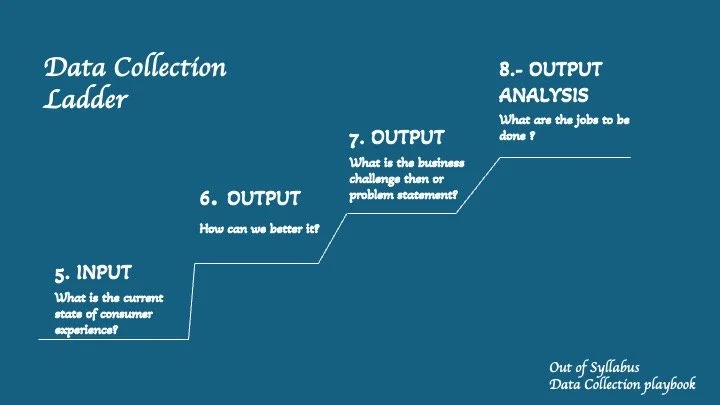5 Key steps for your data collection roadmap.
FIrst of all, why do you need the data?
To understand and analyse consumer behaviour. : At the Category, consumer,city, competition level.
The Data to Brand ladder
Thats where we start from: Charting Your Brand's Future:
In today's competitive landscape, simply having a product isn't enough. Building a strong brand strategy requires a deep understanding of your customers and the journey they take with your offering.
We outline 2 stages and 8 key questions, to help businesses build empathy, define strategic opportunities, and create impactful brand experiences. This framework illustrates a clear path from raw data to a refined brand strategy.
Sprint 1: Empathise – Collecting everything
This foundational sprint focuses on gathering comprehensive insights to understand the current landscape and identify opportunities for value creation. It begins by asking critical questions:
• What is the business ambition? – Defining the overarching goals. - The metrics - What kind of sales figures are we looking at? Revenue targets.
• What do people need? – This delves into understanding your target audience, encompassing who they are, what they are doing, seeing, hearing, and saying, along with their points of pain and points of gain. This involves detailed audience profiling and speaking directly with the target audience.
• What is the cultural narrative? – Examining broader societal trends, such as local brands preference, sustainaibility, rise of korean pop culture.
. Social listening, search patterns,consumer panels, trend reports and press articles are crucial for understanding this narrative.
INPUT: Consumer data, Competition data/Category benchmarks - Include even NPS ratings, market share,share of voice, brand health.
Stage 1 : Get all the inputs
OUTPUT: Where can we create value? – This crucial step bridges initial insights to strategy, identifying the intersection of people's needs (utility, education, entertainment, reward, bonding, self-expression, discovery) and your brand’s purpose and ambition.
Sprint 2: Define – Translating Insights into Actionable Strategy
Once data on consumer and the other 2 C’s is collected,collated and analysed, you need to structure the all the data, insights,implications in a framework. This is where collected data truly begins its transformation into a concrete strategy:
1. What do we know about the current consumer experience?
◦ This involves mapping the consumer journey across stages like Search,Explore,Use,Purchase & Bond.
Under each stage detail out- Triggers, barriers. Overall findings, key insights, and implications are identified.
◦ A variety of data sources and signals are employed to identify opportunities, including Nielsen Comms Point, Brand Health Trackers, Share of Keywords from Mintel and Hit Wise, E-commerce platform search data, Ratings & Reviews, Shopper Study data, Social Listening, Influencer Monitoring, and Depth Interviews.
2. What is the future state we should aim for?
◦ Based on the existing consumer experience, the desired future state is envisioned. For instance, a brand might currently have "high awareness but low engagement" with measures dropping beyond awareness. The future state might aim for increased consideration, improved benefit perception, and a higher rank among promoters.
3. What is the Design Statement?
◦ This is a concise, guiding statement that encapsulates the desired future experience. For example, for a chess club,Mastermoves, the design statement was "To help Mastermoves Chess enable greater attendance rates across its classes’
4. What are the Jobs to be Done (JTBD)?
◦ These are the specific experiences or tasks the brand needs to deliver to achieve the future state, prioritized by their impact across the customer journey stages (Passive, Active, Buy, Use, Advocate).
From Jobs to be Done to Brand Strategy
The Jobs to be Done are the actionable strategic directives derived from all the collected and analyzed data. They explicitly outline the type of experience required to meet both consumer needs and business ambitions. These JTBDs directly inform the brand strategy, guiding decisions on communication, product development, service design, and overall customer engagement.
By systematically moving from building empathy through data collection to defining clear jobs to be done, the "Customer Journey roadmap is complete.
These 2 key steps broken into 4 mini steps each will help you guide your data collection journey roadmap.
Our next blog is about the brand strategy journey after this 2 stages are completed.
The JOBS TO BE DONE STAGE- Your current versus desired experience.


